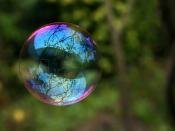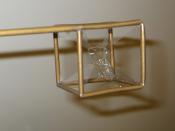Bubbles Imagine trying to wash dishes without a soap solution. It would be hard and things wouldn't get clean. Soap solutions are what make bubbles. Are there soap solutions that make better bubbles? I will test different soap solutions by experiments to see if certain soaps form better bubbles. The tests consist of how big the bubbles get (size) and how long the bubbles last (life span).
There is not one person who knows where or when soap was first made. A rough soap was used in France in about A.D. 100. By the 800s Spain was the leading soap producer. In about 1200 England started to make soap. In the 1700s Nicholas Leblanc discovered that lye could be made from any ordinary table salt. Lye, which is sodium hydroxide, is one of the main ingredients in soap. This discovery made soap affordable for a lot more people. North America's soap industry began in the early 1800's.
Early settlers in North America had made their own soap in kettles. Manufacturers improvements on soap have been big. They have improved the cleaning abilities, color, fragrance, and mildness in soap. Soap is a substance made to help clean things. Fats and chemicals called alkalis are the two main ingredients in soap. Sometimes animal fats or vegetable oils like coconut oil, olive oil, palm oil, soybean oil, and corn oil are common fats used in soap making. Most common alkalis used are sodium hydroxide and potassium hydroxide. When you combine these fats with a water solution of an alkali and add heat the fats decompose forming glycerin and the sodium salt of the fatty acid. The key ingredient of soap is the sodium salt of the fatty acid. Before the 1940's large kettles were used by manufacturers to make soap. Today manufacturers use...


